申请OBU不需要英语证明了,速来本篇文章看看相关内容吧!
发布时间:2020-04-15
ACCA证书的额外福利其中之一是可以申请OBU学士学位,在之前申请OBU学位时,需要提交英语成绩证明,这成为了很多ACCAer的难题。但在改革后,申请OBU学士学位不再需要提供英语水平证明,因为你通过ACCA前九门考试,足以证明你的英文水平已经达到了雅思6分或者PTE54分的水平了。 所以,从现在开始,只需要确保你已经opt-in了OBU项目,等通过前九门考试就可以开始准备起OBU学士学位论文啦!下面就跟51题库考试学习网一起来了解一下吧!
首先,你要满足OBU的要求:
1、已经注册了OBU项目(确保为opted-in状态)如果没有注册该项目,可以在通过FR、AA、FM任意一门之前申请注册,如果已经通过任意一门,那么将无法重新注册。
2、在上交论文至少两个月前通过前九门科目的考试,要注意其中FR、AA、FM三个科目不可免考。
3、完成ACCA的道德模块
4、完成论文
5、需要在第一次通过ACCA的考试或者第一次获得免考的10年内完成学位的申请
6、及时支付ACCA年费,欠费状态下无法申请
论文有什么要求?
论文包括7500字的Research Report(RR)和2000字的Skills and Learning Statement(SLS)。在这个过程当中,OBU要求每个学员有对应的注册论文导师,注册论文导师需要与学员有至少3次讨论,每次30分钟。
学员在需要在最后一次讨论中对导师进行15分钟的演讲,演讲的PPT页数限制在20页,而这份PPT是需要与RR和SLS一并上交给OBU的,OBU还会与导师确认学员是否真的进行了演讲。所以,上交的内容有RR、SLS以及PPT。
其中RR是基于OBU提供的20个主题中,选择其中的一个进行研究报告的写作。对于某些主题,比如Topic8和Topic15要特别小心,因为行业是有相关要求的,也就是说不能随随便便写任意一个行业企业的分析,应该限制在OBU要求的行业中进行选择。
以上就是今天51题库考试学习网为大家带来的全部内容了,如果大家还想了解更多关于考试的资讯,请关注51题库考试学习网,51题库考试学习网祝您生活愉快!
下面小编为大家准备了 ACCA考试 的相关考题,供大家学习参考。
(b) Prepare a consolidated balance sheet as at 31 October 2005 for the Lateral Group in accordance with
International Financial Reporting Standards. (21 marks)
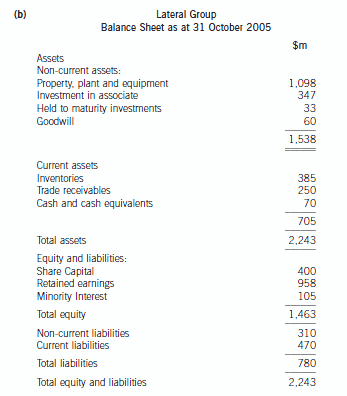
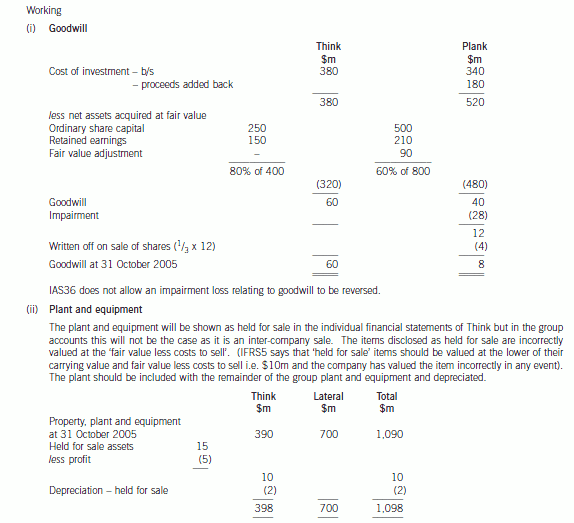
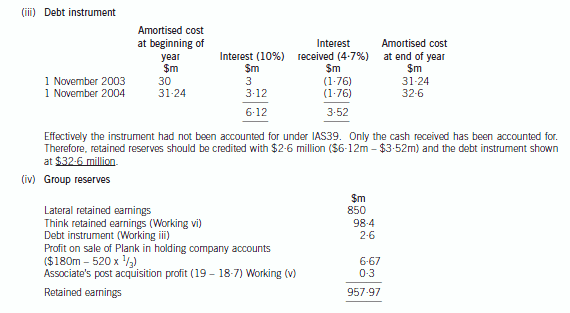
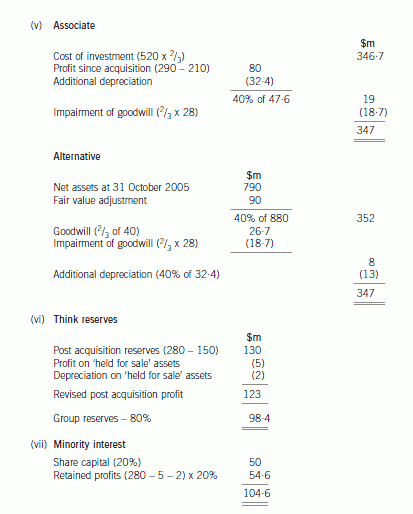
4 Assume today’s date is 15 May 2005.
In March 1999, Bob was made redundant from his job as a furniture salesman. He decided to travel round the world,
and did so, returning to the UK in May 2001. Bob then decided to set up his own business selling furniture. He
started trading on 1 October 2001. After some initial success, the business made losses as Bob tried to win more
customers. However, he was eventually successful, and the business subsequently made profits.
The results for Bob’s business were as follows:
Period Schedule D Case I
Trading Profits/(losses)
£
1 October 2001 – 30 April 2002 13,500
1 May 2002 – 30 April 2003 (18,000)
1 May 2003 – 30 April 2004 28,000
Bob required funds to help start his business, so he raised money in three ways:
(1) Bob is a keen cricket fan, and in the 1990s, he collected many books on cricket players. To raise money, Bob
started selling books from his collection. These had risen considerably in value and sold for between £150 and
£300 per book. None of the books forms part of a set. Bob created an internet website to advertise the books.
Bob has not declared this income, as he believes that the proceeds from selling the books are non-taxable.
(2) He disposed of two paintings and an antique silver coffee set at auction on 1 December 2004, realising
chargeable gains totalling £23,720.
(3) Bob took a part time job in a furniture store on 1 January 2003. His annual salary has remained at £12,600
per year since he started this employment.
Bob has 5,000 shares in Willis Ltd, an unquoted trading company based in the UK. He subscribed for these shares
in August 2000, paying £3 per share. On 1 December 2004, Bob received a letter informing him that the company
had gone into receivership. As a result, his shares were almost worthless. The receivers dealing with the company
estimated that on the liquidation of the company, he would receive no more than 10p per share for his shareholding.
He has not yet received any money.
Required:
(a) Write a letter to Bob advising him on whether or not he is correct in believing that his book sales are nontaxable.
Your advice should include reference to the badges of trade and their application to this case.
(9 marks)
(a) Evidence of trading
[Client address]
[Own address]
[Date]
Dear Bob,
I note that you have been selling some books in order to raise some extra income. While you believe that the sums are not
taxable, I believe that there may be a risk of the book sales being treated as a trade, and therefore taxable under Schedule D
Case I. We need to refer to guidance in the form. of a set of principles known as the ‘badges of trade’. These help determine
whether or not a trade exists, and need to be looked at in their entirety. The badges are as follows.
1. The subject matter
Some assets can be enjoyed by themselves as an investment, while others (such as large amounts of aircraft linen) are
clearly not. It is likely that such assets are acquired as trading stock, and are therefore a sign of trading. Sporting books
can be an investment, and so this test is not conclusive.
2. Frequency of transactions
Where transactions are frequent (not one-offs), this suggests trading. You have sold several books, which might suggest
trading, although you have only done this for a short period - between one and two years.
3. Length of ownership
Where items are bought and sold soon afterwards, this indicates trading. You bought your books in the 1990s, and the
length of time between acquisition and sale would not suggest trading.
4. Supplementary work and marketing
You are actively marketing the books on your internet website, which is an indication of trading.
5. Profit motive
A motive to make profit suggests trading activity. You sold the books to raise funds for your property business, and not
to make a profit as such, which suggests that your motive was to raise cash, and not make profits.
6. The way in which the asset sold was acquired.
Selling assets which were acquired unintentionally (such as a gift) is not usually seen as trading. You acquired the books
for your collection over a period of time, and while these were intentional acquisitions, the reasons for doing so were for
your personal pleasure.
By applying all of these tests, it should be possible to argue that you were not trading, merely selling some assets in
order to generate short-term cash for your business.
The asset disposals will be taxed under the capital gain tax rules, but as the books are chattels and do not form. part of
a set, they will be exempt from capital gains tax.
Yours sincerely
A N. Accountant
2 Ice-Time Ltd (ITL) manufactures a range of sports equipment used in a variety of winter-sports in Snowland.
Development engineers within ITL have recently developed a prototype of a small engine-propelled bobsleigh named
the ‘Snowballer’, which has been designed for use by young children. The directors of ITL recently spent £200,000
on market research, the findings of which led them to believe that a market exists for the Snowballer.
The marketing director has suggested that ITL should use the ‘Olympic’ brand in order to market the Snowballer.
The finance director of ITL has gathered relevant information and prepared the following evaluation relating to the
proposed manufacture and sale of the Snowballer.
(1) Sales are expected to be 3,200 units per annum at a selling price of £2,500 per unit.
(2) Variable material, labour, and overhead costs are estimated at £1,490 per unit.
(3) In addition, a royalty of £150 per unit would be payable to Olympic plc, for the use of their brand name.
(4) Fixed overheads are estimated at £900,000 per annum. These overheads cannot be avoided until the end of the
year in which the Snowballer is withdrawn from the market.
(5) An initial investment of £5 million would be required. A government grant equal to 50% of the initial investment
would be received on the date the investment is made. However, because the Snowballer would be classified as
a luxury good, no tax allowances would be available on this initial investment. The estimated life cycle of the
Snowballer is six years.
(6) Corporation tax at the rate of 30% per annum is payable in the year in which profit occurs.
(7) All cash flows are stated in current prices and, with the exception of the initial investment and the government
grant, will occur at the end of each year.
(8) The nominal cost of capital is 15·44%. Annual inflation during the period is expected to amount to 4%.
Required:
(a) Calculate the net present value (NPV) of the Snowballer proposal and recommend whether it should be
undertaken by the directors of ITL. (4 marks)
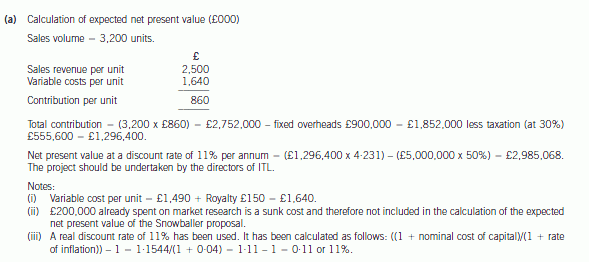
(b) Assess the benefits of the separation of the roles of chief executive and chairman that Alliya Yongvanich
argued for and explain her belief that ‘accountability to shareholders’ is increased by the separation of these
roles. (12 marks)
(b) Separation of the roles of CEO and chairman
Benefits of separation of roles
The separation of the roles of chief executive and chairman was first provided for in the UK by the 1992 Cadbury provisions
although it has been included in all codes since. Most relevant to the case is the terms of the ICGN clause s.11 and OECD
VI (E) both of which provide for the separation of these roles. In the UK it is covered in the combined code section A2.
The separation of roles offers the benefit that it frees up the chief executive to fully concentrate on the management of the
organisation without the necessity to report to shareholders or otherwise become distracted from his or her executive
responsibilities. The arrangement provides a position (that of chairman) that is expected to represent shareholders’ interests
and that is the point of contact into the company for shareholders. Some codes also require the chairman to represent the
interests of other stakeholders such as employees.
Having two people rather than one at the head of a large organisation removes the risks of ‘unfettered powers’ being
concentrated in a single individual and this is an important safeguard for investors concerned with excessive secrecy or
lack of transparency and accountability. The case of Robert Maxwell is a good illustration of a single dominating
executive chairman operating unchallenged and, in so doing, acting illegally. Having the two roles separated reduces
the risk of a conflict of interest in a single person being responsible for company performance whilst also reporting on
that performance to markets. Finally, the chairman provides a conduit for the concerns of non-executive directors who,
in turn, provide an important external representation of external concerns on boards of directors.
Tutorial note: Reference to codes other than the UK is also acceptable. In all cases, detailed (clause number) knowledge
of code provisions is not required.
Accountability and separation of roles
In terms of the separation of roles assisting in the accountability to shareholders, four points can be made.
The chairman scrutinises the chief executive’s management performance on behalf of the shareholders and will be
involved in approving the design of the chief executive’s reward package. It is the responsibility of the chairman to hold
the chief executive to account on shareholders’ behalfs.
Shareholders have an identified person (chairman) to hold accountable for the performance of their investment. Whilst
day-to-day contact will normally be with the investor relations department (or its equivalent) they can ultimately hold
the chairman to account.
The presence of a separate chairman ensures that a system is in place to ensure NEDs have a person to report to outside the
executive structure. This encourages the freedom of expression of NEDs to the chairman and this, in turn, enables issues to
be raised and acted upon when necessary.
The chairman is legally accountable and, in most cases, an experienced person. He/she can be independent and more
dispassionate because he or she is not intimately involved with day-to-day management issues.
声明:本文内容由互联网用户自发贡献自行上传,本网站不拥有所有权,未作人工编辑处理,也不承担相关法律责任。如果您发现有涉嫌版权的内容,欢迎发送邮件至:contact@51tk.com 进行举报,并提供相关证据,工作人员会在5个工作日内联系你,一经查实,本站将立刻删除涉嫌侵权内容。
- 2020-04-28
- 2020-01-09
- 2020-05-14
- 2020-03-07
- 2020-04-21
- 2020-01-10
- 2020-01-10
- 2020-01-09
- 2020-01-10
- 2020-04-15
- 2020-05-10
- 2020-03-07
- 2020-04-08
- 2020-01-10
- 2020-01-10
- 2020-03-13
- 2020-04-30
- 2020-05-09
- 2020-01-10
- 2020-02-19
- 2020-01-09
- 2020-03-26
- 2020-01-11
- 2020-01-09
- 2020-03-07
- 2020-01-09
- 2020-01-10
- 2020-01-09
- 2020-01-10
- 2020-01-10